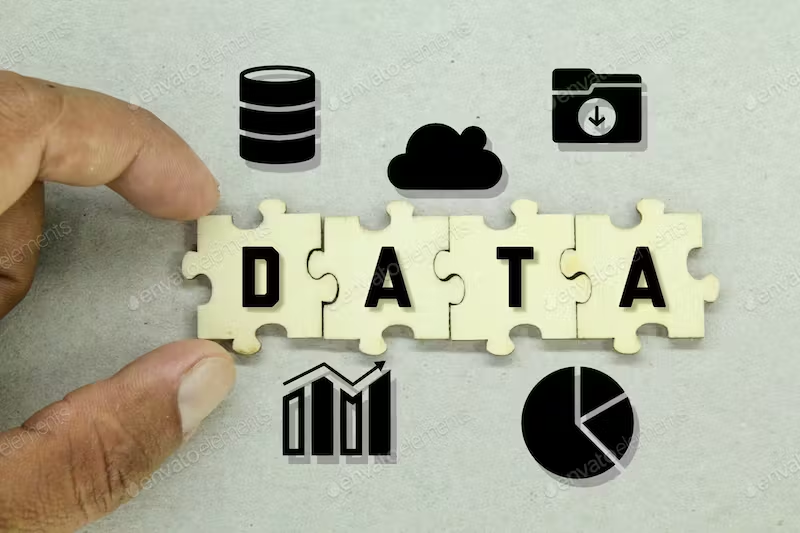Data science for business is like rocket fuel for innovation and success. It empowers businesses to unlock hidden insights and make data-driven decisions. As a result, it becomes easy to propel the growth of a business to new heights.
It is not just about crunching numbers and analyzing data. Data science is about harnessing the power of data to transform industries. It proves useful to create new possibilities and disrupt the status quo.
Data science is a necessity, not a luxury, in the current business world. No doubt, it is a game-changer that fuels innovations. Plus, it revolutionizes the way businesses operate.
Your business can get a competitive edge by getting deep insights into the following:
Market Trends
Customer Behavior
Operational Efficiencies
It empowers businesses to automate tasks, optimize processes, and make strategic decisions that drive business success.
Importance of Data Science in the Business World
Datascience plays an important roleinthe modern business world. It is becoming essential for organizations to thrive and succeed in this competitive environment. And so businesses are increasingly implementing training through the Applied Data Science program for their employees.
Here are some key points to show the importance of data science in the business world:
- Data science empowers businesses to make data-driven decisions based on insights and evidence extracted from data.
- Businesses can better understand customer needs, behaviors, and preferences by analyzing data. It allows you to analyze online transactions, social media, and customer interaction data.
- Data science helped businesses optimize their operations by streamlining processes, identifying inefficiencies, and automating repetitive tasks. It will lead to improved productivity and cost savings.
- Businesses can analyze customer data, create personalized marketing campaigns, and offer tailored solutions to customer preferences. It will increase customer engagement and loyalty.
- Data science helps businesses detect and prevent fraud, identify potential risks, and develop risk mitigation strategies. It is possible by analyzing patterns and anomalies in data.
Uses Cases and Applications of Data Science in Businesses
Some common use cases and applications of data science in business include:
- Predictive analytics for sales forecasting, inventory management, and demand forecasting.
- Customer segmentation and profiling to better understand customer behavior and preferences.
- Sentiment analysis and social media analytics to analyze customer’s feedback and sentiment towards products or services.
- Customer retention analysis and churn prediction to identify customers at risk of leaving and take proactive measures to retain them.
- Fraud detection and anomaly detection to detect and prevent fraudulent activities.
- A/B testing and experimentation to optimize marketing campaigns and website performance.
- Natural language processing (NLP) for sentiment analysis and text analysis.
If you want help to leverage the power of data science for your business, consider professional service providers like Lucrative Studio.
The Role of Data Science in Business Decision Making
Let’s explore how data science empowers better decision-making with uses cases and examples:
Data-Driven Decision Making
Data-driven decision-making involves using data to inform and guide business decisions. You can access data from sales transactions, social media, customer interactions, etc.
Use this data to make decisions instead of relying on opinions and gut instincts. It will reduce the risk of subjective and biased judgments.
Data-based decisions help businesses identify trends, correlations, and patterns in data. You will get insights into:
- Customer preferences
- Operational efficiencies
- Market trends
- Financial performance
It will lead to more strategic and informed decisions. With data-based decisions, businesses can measure and track the impact of their decisions.
Data science combines statistical analysis, domain expertise, and machine learning for better decision-making.
It involves advanced techniques to process, analyze and interpret large and complex data sets.
With these techniques, data scientists extract meaningful insights to make informed decisions.
Predictive Analytics
Predictive analytics involves using advanced data science techniques to analyze historical data. It helps you make market predictions about future trends and outcomes.
Here is how predictive analytics can help businesses forecast future trends and reduce risks:
Forecasting Future Trends
Predictive analysis leverages historical data and statistical algorithms to forecast patterns, behaviors, and future trends.
By analyzing past data, businesses can identify trends and patterns. As a result, they can make informed predictions about future outcomes.
For example, you can use predictive analytics to forecast product and service demand. Anticipate changes in customer preferences and predict market trends.
With these insights, you can proactively plan and adapt your strategies to stay ahead of the competition. Plus, it will be easy for you to capitalize on emerging opportunities.
Reducing Risks and Uncertainties
Predictive analysis helps businesses mitigate risks and uncertainties. As a business owner, you can get insights into potential risks and their probabilities.
With predictive analysis, you can anticipate and assess risks for your business. For example:
- Supply chain disruptions
- Market fluctuations
- Operational issues
It helps you take proactive measures for your business to mitigate risks and minimize their impact on financial performance and operations.
Moreover, predictive analysis helps you in risk modeling, scenario planning, and simulation analysis. It enables you to make data-driven decisions to reduce uncertainties and optimize outcomes.
Data Science in Marketing and Sales
Data science plays a significant role in marketing and sales. It revolutionizes how businesses:
- Understand and engage with their customers
- Optimize their marketing strategies
- Drive sales growth
Here is how data science is transforming marketing and sales:
Customer Segmentation and Targeting
Data science allows businesses to segment their customer base. You can identify your key customer segments with similar behavior and characteristics.
By analyzing purchasing history, demographic information, social media interaction, and online behavior, you can create detailed customer profiles for your business.
Plus, you can tailor your marketing and sales efforts to specific segments. This enables you to deliver personalized and relevant messages, experiences, and efforts.
It may result in loyalty, higher customer engagement, and conversion rates.
Use Case for Tailoring Marketing Campaigns
With the help of data science, you can tailor marketing campaigns to suit the unique needs and preferences of your customers. Here is a use case for better understanding:
An e-Commerce company wants to improve its marketing efforts to increase online sales. They collect data from the CRM system, their website, and social media platforms.
- They use descriptive analytics and data visualization techniques to gain insights into customer behaviors like product preferences, purchase history, and browsing patterns.
- The company segments customers based on buying behavior, engagement levels, and demographics. It helps them create personalized content, such as email newsletters with product recommendations.
- They also create customized social media ads that target specific customer segments with relevant products. With the help of predictive analysis, the company identifies the frequency and optimal timing for its marketing campaigns.
- After analyzing the past data, they determine the best days and times to send marketing messages to different customer segments. To make decisions, the company considers time zones, weekdays and weekends, and customer engagement patterns.
- The company conducts A/B testing to experiment with different messaging, creative elements, and marketing strategies. They track key metrics, such as the revenue generated from the campaigns, conversion rates, and click-through rates.
- With this data, they evaluate the success of their marketing campaigns and make data-driven decisions to refine their strategies.
Data Science in Product Development – Use Case
Do you know how data science can be applied in product development?
You can better understand this with a use case.
An electronics company wants to develop a new smartwatch that meets the needs and preferences of its target market.
They use data science techniques to gather insights from consumer feedback, market research, and competitor analysis to make informed decisions.
The company applies data science in the following ways:
Market Research and Analysis
The company analyzes consumer demographics, purchasing behavior, and preferences to identify demand patterns, potential opportunities, and market trends.
Understanding the market landscape allows them to develop products that align with consumer preferences and needs. It will increase their likelihood of success in the market.
Identifying Consumer Needs and Preferences
The company uses surveys, sentiment analysis, and focus groups to gather consumer feedback on its existing products and competitors’ products.
After analyzing this data, they can identify consumer needs, preferences, and pain points related to smartwatches. For example:
- Designer features
- Design preferences
- Price points
- User experience expectations
This can help them develop a product that resonates with their target market.
Competitive Analysis
The company analyzes data on its competitors, including market share, customer reviews, pricing, and product features.
By Understanding the weaknesses and strengths of their competitors, they can identify opportunities to differentiate their products. Plus, they can develop a competitive advantage.
With these efforts, they can position their smartwatches effectively in the market.
Product Optimization
The company uses product performance data, usability testing, and user feedback to optimize its product features and design.
With this data, they analyze their product for improvement, such as sensor accuracy, battery life, user interface, and overall product performance.
This can help them refine their product to meet customer needs and preferences.
Enhancing Product Features and Functionalities
The electronic company uses machine learning and user behavior analysis to enhance the features and functionalities of its products.
They analyze data to identify popular features and prioritize new ones according to customer preferences. It helps them personalize the user experience based on individual usage patterns.
Identifying Areas for Improvement
The company uses product performance data, customer reviews, and user feedback to identify improvement areas.
By analyzing this data, they identify customer complaints, product flaws, and areas where product performance falls short of expectations.
The electronics company can optimize the product development process based on the insights gained from data analysis and data-driven decisions.
It will result in a smartwatch that aligns with customer needs and preferences. Plus, it will deliver a superior user experience.
Data Science in Operations and Supply Chain Management
With the help of data science, you can optimize operations and supply change management. See the applications of data science:
Process Optimization
You can analyze data on resource utilization, cycle times, and process parameters with data science techniques, such as process mining, optimization, and simulation.
These techniques will help you identify inefficiencies and bottlenecks in operations and supply chain processes.
You can reduce costs, improve productivity, and streamline processes with data-driven solutions.
Demand Forecasting
You should analyze historical data, market trends, and customer behavior for demand forecasting. It will help you forecast the demand for your products.
Accurate demand forecasting can help you optimize inventory levels, resource allocation, and production planning.
It will ensure the availability of the right products at the right time. In fact, it is a good way to reduce overstock and stockouts.
To optimize inventory and logistic decisions, analyze data on transportation costs, inventory levels, lead times, and customer demand.
You should determine the following:
- Reorder points
- Transportation routes
- Safety stock levels
- Warehouse locations
- Reducing inventory costs and transportation costs
- Improving customer satisfaction
- Anticipating customer needs
Data science can analyze customer data, such as feedback, preferences, browsing behavior, and purchase history, to anticipate customer needs and preferences.
It allows you to personalize product offerings, promotions, and customer experiences.
Data Science in Human Resources and Talent Management
Data science can help HR teams to identify top talent effectively by analyzing large volumes of data. It is a good way to mitigate and identify unconscious biases in the hiring process.
With data science, human resources can analyze data on job applicants, such as resumes, qualifications, experience, and assessments.
It proves helpful in identifying top talents, assessing their fit for the organization, and making data-driven decisions.
Data science helps you promote diversity and inclusion in the recruitment process.
Employee Performance Analytics
Data science helps you analyze employee performance, feedback, and engagement data.
Human resource professionals can identify skill gaps and recommend training and development opportunities.
As a result, organizations can make data-driven decisions regarding performance, evaluation, promotions, and talent development strategies.
Data science in Finance and Risk management
Data science provides valuable insights to financial professionals derived from analyzing large volumes of data. See its benefits:
Fraud Detection and Prevention
Data science can analyze large volumes of data, such as customer behavior, transaction records, and patterns of fraudulent activities. It helps financial professionals develop:
- Predictive models
- Machine learning techniques
- Anomaly detection algorithms
So businesses can identify suspicious transactions and implement preventive measures. It will help you reduce financial losses due to fraud.
Credit Risk Assessment
Data science can analyze data on customer credit history, financial statements, credit scores, and other factors. It proves helpful to assess credit risk and evaluate customer creditworthiness.
This enables financial institutions to make informed decisions regarding lending strategies, loan approvals, and risk management.
Integrating Data Science with Squarespace and Other Platforms
Do you want to optimize your online presence? You can’t do it without data science because it helps you implement data-driven marketing strategies.
Enhancing Website Performance
Data science can analyze data on website security, performance, user behavior, and conversion rates to optimize website design, content, and user experience.
You can use Squarespace analytics tools or other platforms to analyze website traffic and identify user preferences.
It will help you implement data-driven marketing strategies to increase website conversions and achieve online business goals.
Implementing Data-Driven Marketing Strategies
Data science helps you combine data from various sources, including Squarespace or other platforms, to gain insights into customer behavior, preferences, and trends.
This allows organizations to make data-driven decisions regarding website design, content creation, and marketing strategies. It will help businesses enhance their online presence and achieve a competitive advantage.
Combining Data Science with Squarespace for Effective Online Presence
Here are some easy steps to combine data science with Squarespace:
Collect relevant data from your Squarespace website, such as conversion data, user behavior data, website traffic data, etc. You will get a built-in analytics tool from Squarespace to collect data.
Analyze this data with data science techniques, such as machine learning algorithms, statistical analysis, and data visualization techniques. It will help you uncover trends, patterns, and correlations in the data.
Based on the data analysis insights, you can identify areas of your website that need optimization. It may include user experience, marketing strategies, website design, and content.
Develop data-driven strategies like personalized content, tailored promotions, and targeted marketing campaigns.
Now you can implement changes, such as updating your website content and design. Modify marketing campaigns based on the insights of the data analysis.
After implementing changes, you will monitor them to evaluate the performance of your website using relevant metrics and analytics tools. This will help you evaluate the effectiveness of data-driven strategies.
With an iterative data science process, you can regularly review data and adjust your strategies based on the latest insights and trends.
Conclusion
In short, data science plays an important role in the development and growth of modern businesses. It offers a wide range of applications across various domains, including operations, sales, marketing, product development, human resources, risk management, and finance.
It enables businesses to make informed decisions, get insights and optimize processes. As a result, it helps you enhance customer experience. Ultimately, it will lead your business toward better performance, success, and growth.
As a business owner, you should recognize the value of data science and leverage its capabilities to gain a competitive advantage. By harnessing the power of data science, businesses can:
- Unlock hidden opportunities
- Identify areas of improvement
- Make data-driven decisions to drive the best outcomes
Lucrative Studio provides tailored solutions for businesses to optimize their Squarespace website, improve user experiences, and drive conversions.
From data collection and analysis to developing data-driven strategies and implementing changes, we can help businesses leverage the power of data science. And achieve their business objectives on any platform.
Make sure to embrace data science in business decision-making. It will improve your business’s performance, growth, and success in today’s competitive landscape.







